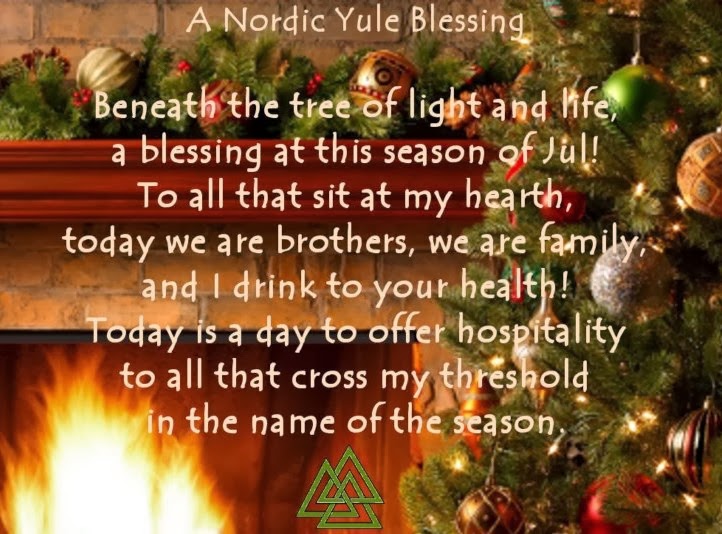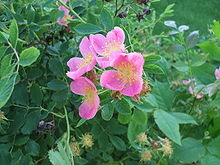Wassail is a hot, mulled punch often associated with Yuletide, drunk from a 'wassailing bowl'. The earliest versions were warmed mead into which roasted crab apples were dropped and burst to create a drink called 'lambswool' drunk on Lammas day, still known in Shakespeare's time.[2] Later, the drink evolved to become a mulled cider made with sugar, cinnamon, ginger and nutmeg, topped with slices of toast as sops and drunk from a large communal bowl. Modern recipes begin with a base of wine, fruit juice or mulled ale, sometimes with brandy or sherry added. Apples or oranges are often added to the mix, and some recipes also call for beaten eggs to be tempered into the drink. Great bowls turned from wood, pottery or tin often had many handles for shared drinking and highly decorated lids; antique examples can still be found in traditional pubs.Hence the first stanza of the traditional carol the Gloucestershire Wassail dating back to the Middle Ages.
At Carhampton, near Minehead, the Apple Orchard Wassailing is held on the old Twelfth Night (17 January) as a ritual to ask the Gods for a good apple harvest. The villagers form a circle around the largest apple tree, hang pieces of toast soaked in cider in the branches for the robins, who represent the 'good spirits' of the tree. A shotgun is fired overhead to scare away evil spirits and the group sings, the following being the last verse,
Lamb's wool
Lamb's wool or lambswool is a variety of wassail made from ale, baked apples, sugar and spices.[
Irish antiquarian Charles Vallancey proposed that the name "lambswool" was a corruption of the name of a pagan Irish festival, "Lamas Ubhal", during which a similar drink was had. Alternatively, the name may derive from the drink's similar appearance to the wool of lambs. Ale is occasionally replaced by ginger ale for children, especially around Halloween and New Year.
Culture
This drink would be roughly equivalent to beer or wine in many contemporary Western cultures. People drank it at social gatherings. "Come butler, come fill us a bowl of the best/... please God send our master a good cask of ale..." sung throughout the towns of the Germanic nations, sending good luck to one's master in the new year.
Wassailing
Here's to thee, old apple tree,
That blooms well, bears well.
Hats full, caps full,
Three bushel bags full,
An' all under one tree. Hurrah! Hurrah!
That blooms well, bears well.
Hats full, caps full,
Three bushel bags full,
An' all under one tree. Hurrah! Hurrah!
Here’s to thee, old apple-tree,
Whence thou mayst bud, and whence thou mayst blow,
And whence thou mayst bear apples enow! [enough]
Hats-full! Caps-full!
Bushel, bushel sacks-full!
And my pockets full, too! Hurra![10]
Whence thou mayst bud, and whence thou mayst blow,
And whence thou mayst bear apples enow! [enough]
Hats-full! Caps-full!
Bushel, bushel sacks-full!
And my pockets full, too! Hurra![10]
In the cider-producing counties in the South West of England (primarily Cornwall, Devon, Somerset, Dorset, Gloucestershire and Herefordshire) or South East England (Kent, Sussex, Essex and Suffolk) wassailing refers to a traditional ceremony that involves singing and drinking to the health of trees on Twelfth Night in the hopes that they might better thrive. The purpose of wassailing is to awaken the cider apple trees and to scare away evil spirits to ensure a good harvest of fruit in the Autumn.The ceremonies of each wassail vary from village to village but they generally all have the same core elements. A wassail King and Queen lead the song and/or a processional tune to be played/sung from one orchard to the next; the wassail Queen is then lifted into the boughs of the tree where she places toast soaked in wassail from the clayen cup as a gift to the tree spirits (and to show the fruits created the previous year). In some counties the youngest boy or "Tom Tit" will stand in for the Queen and hang the cider soaked toast in the tree. Then an incantation is usually recited.
A folktale from Somerset reflecting this custom tells of the Apple Tree Man, the spirit of the oldest apple tree in an orchard, and in whom the fertility of the orchard is thought to reside. In the tale a man offers his last mug of mulled cider to the trees in his orchard and is rewarded by the Apple Tree Man who reveals to him the location of buried gold.

















/about/NepetaSiberica2_6_19_04-56a344655f9b58b7d0d12e64.jpg)